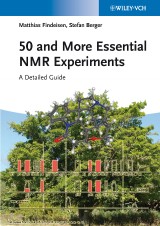Details

50 and More Essential NMR Experiments
A Detailed Guide1. Aufl.
|
70,99 € |
|
| Verlag: | Wiley-VCH |
| Format: | |
| Veröffentl.: | 30.07.2013 |
| ISBN/EAN: | 9783527336968 |
| Sprache: | englisch |
| Anzahl Seiten: | 316 |
DRM-geschütztes eBook, Sie benötigen z.B. Adobe Digital Editions und eine Adobe ID zum Lesen.
Beschreibungen
This book is the perfect link for learning how to perform the experiments after only having studied theory. In eight chapters more than 50 essential NMR experiments are described in detail. Special focus is put on the organic set of NMR spectra (1H, 13C-APT, COSY, NOESY, HSQC and HMBC). Different chapters deal with advanced organic NMR, selective methods, heteronuclear NMR, relaxation and diffusion measurements, organic applications and maintenance. Every experiment has a section providing the reader with the purpose and scope of the specific experiment. Every experiment is concluded with the spectrum as it is obtained under the conditions described. Questions<br> and comments enable the reader to check their understanding. The authors are very experienced and the whole book is in full color, which enhances the reading experience and makes the spectra and other figures easier to understand.<br> <br> This book is strongly recommended for all students and researchers who are involved in the structural elucidation of chemical compounds both in practical education and in pursuing research, in particular if they handle an NMR spectrometer.
PREFACE<br> <br> THE ORGANIC SET OF NMR SPECTRA <br> The 1H NMR Experiment<br> APT-13C NMR <br> COSY <br> NOESY <br> HSQC <br> HMBC <br> <br> ADVANCED ORGANIC NMR SPECTROSCOPY <br> 2D J-Resolved 1H NMR Spectroscopy <br> ROESY <br> TOCSY <br> HSQC-TOCSY <br> HOESY<br> INADEQUATE<br> ADEQUATE<br> J-HMBC <br> Gated Decoupling <br> <br> SELECTIVE METHODS <br> Water suppression by Presaturation <br> Solvent Suppression by 1D-NOESY<br> Water Suppression by SOGGY Excitation Sculpting <br> Solvent Suppression using WET <br> SELTOCSY <br> SELNOESY<br> SELINCOR <br> SELINQUATE <br> Band Selective HMBC <br> <br> HETERONUCLEAR NMR <br> 11B NMR Spectroscopy <br> 15N NMR Spectroscopy <br> 17O NMR Spectroscopy <br> 19F NMR Spectroscopy<br> 29Si NMR Spectroscopy<br> 57Fe NMR Spectroscopy <br> 195Pt NMR Spectroscopy <br> <br> EXPERIMENTS IN PHYSICAL ORGANIC CHEMISTRY<br> Measurement of the Spin -<br> Lattice Relaxation Time T1 <br> Measurement of the Spin -<br> Spin Relaxation Time T2 <br> Dynamic 1H NMR Spectroscopy <br> Diffusion Measurement with DOSY <br> Residual Dipolar Couplings (RDC) <br> <br> ORGANIC CHEMISTRY APPLICATIONS <br> ASIS <br> Chirality Determination <br> Advanced Mosher Method <br> Quantitative NMR and Relaxation Reagents <br> Determination of Association Constants Ka <br> STD NMR <br> A Kinetic Experiment<br> <br> AN EXCURSION TO THE SOLID STATE AND TO STRUCTURAL BIOLOGY <br> The CP/MAS Experiment <br> High-Resolution Magic-Angle Spinning<br> HN-HSQC <br> HNCA <br> <br> MAINTENANCE AND CALIBRATION <br> Calibration of Pulse Duration in the Transmitter Channel<br> Calibration of the Pulse Duration in the Indirect Channel <br> Shaped Pulses<br> Adiabatic pulses <br> Temperature Calibration in NMR <br> Calibration of Pulsed Field Gradients <br> <br> APPENDIX<br> Answers<br> Pulse Programs <br> Elementary Product Operator Formalism Rules <br> Chemical Shift and Spin-Coupling Data for Strychnine <br> Picture Credits <br> <br> INDEX <br>
Matthias Findeisen studied Physics at the University of Leipzig. During his Diploma course he joined 1979 the group of Prof. Artur Losche, who<br> established in the fifties radio frequency spectroscopy in the Physical Institute and was one of the pioneers in NMR in East Germany. This<br> gave M.F. a little taste of NMR and, had been nosey, he stayed there for his PhD work on the field of liquid crystalline substances.<br> Afterwards he switched to the East German Academy of Science in Leipzig and operated an NMR routine lab, which focused him to NMR<br> in liquids and chemical analytical problems. Returning back to the Leipzig University in 1992 he kept this focus in the group of Prof. R.<br> Borsdorf, later on conducted by Stefan Berger, than concentrating to methodological NMR subjects.<br> <br> Stefan Berger was intrigued by NMR after having won a bottle of beer during an introductory course in organic NMR led by Prof. H. Suhr at<br> the University Tubingen in 1968. After a PhD thesis with Prof. Anton Rieker, in 1973 he joined Prof. J. D. Roberts at Caltec for postdoctoral<br> work, where he also met Prof. D. M. Grant and Prof. D. Seebach, who were then guest professors in Pasadena. This period was decisive in<br> trying for a Habilitation in NMR spectroscopy, which was achieved at the University Marburg. At the University of Leipzig he tries to combine<br> methodological development of NMR with its application to bioorganic problems.
This book is the perfect link for learning how to perform the experiments after only having studied theory. In eight chapters more than 50 essential NMR experiments are described in detail. Special focus is put on the organic set of NMR spectra (1H, 13C-APT, COSY, NOESY, HSQC and HMBC). Different chapters deal with advanced organic<br />NMR, selective methods, heteronuclear NMR, relaxation and diffusion measurements, organic applications and maintenance. Every experiment has a section providing the reader with the purpose and scope of the specific experiment. Every experiment is concluded with the spectrum as it is obtained under the conditions described. Questions and comments enable the reader to check their understanding. The authors are very<br />experienced and the whole book is in full color, which enhances the reading experience and makes the spectra and other figures easier to understand. <br /><br />This book is strongly recommended for all students and researchers who are involved in the structural elucidation of chemical compounds both in practical education and in pursuing research, in particular if they handle an NMR spectrometer.
Diese Produkte könnten Sie auch interessieren:

Chemistry for the Protection of the Environment 4

von: Robert Mournighan, Marzenna R. Dudzinska, John Barich, Marjorie A. Gonzalez, Robin K. Black

213,99 €















